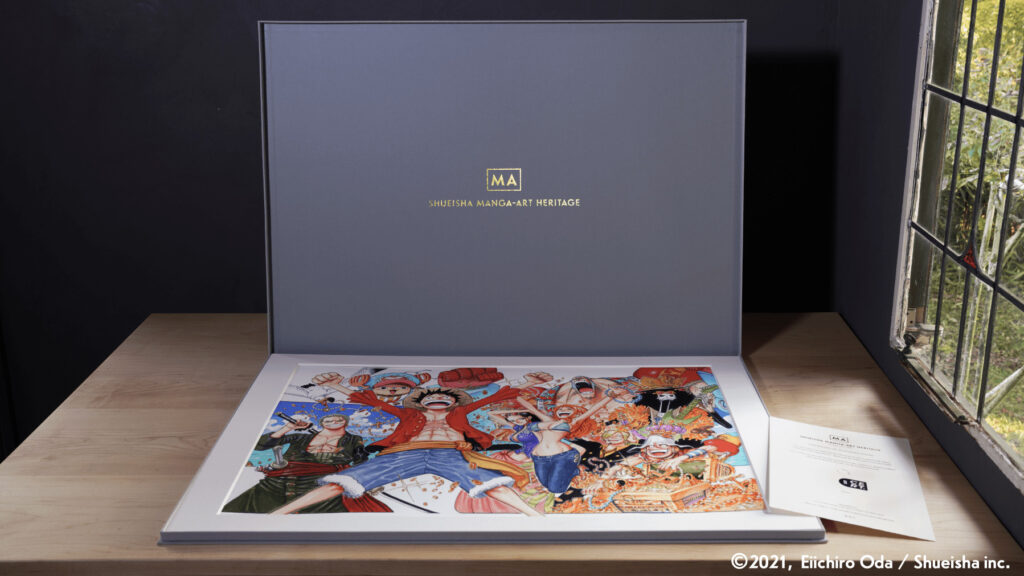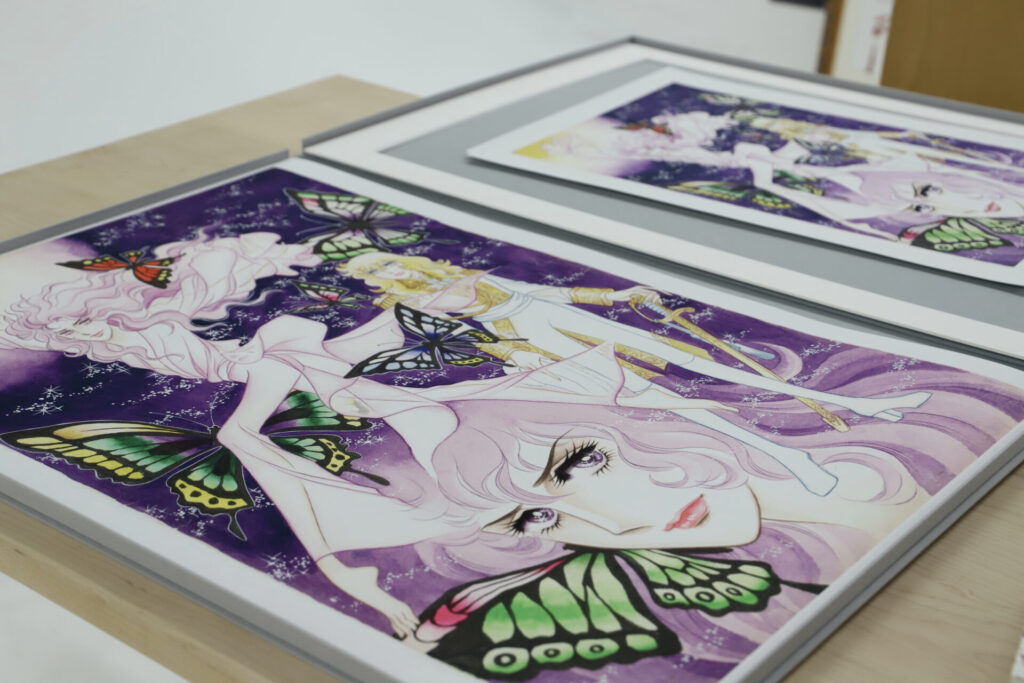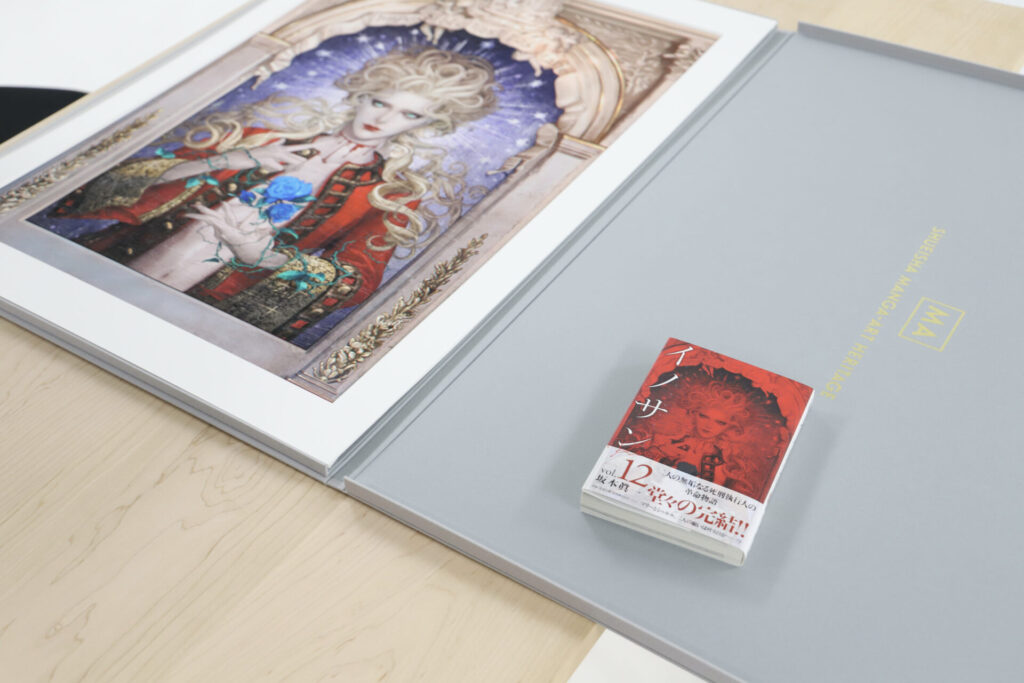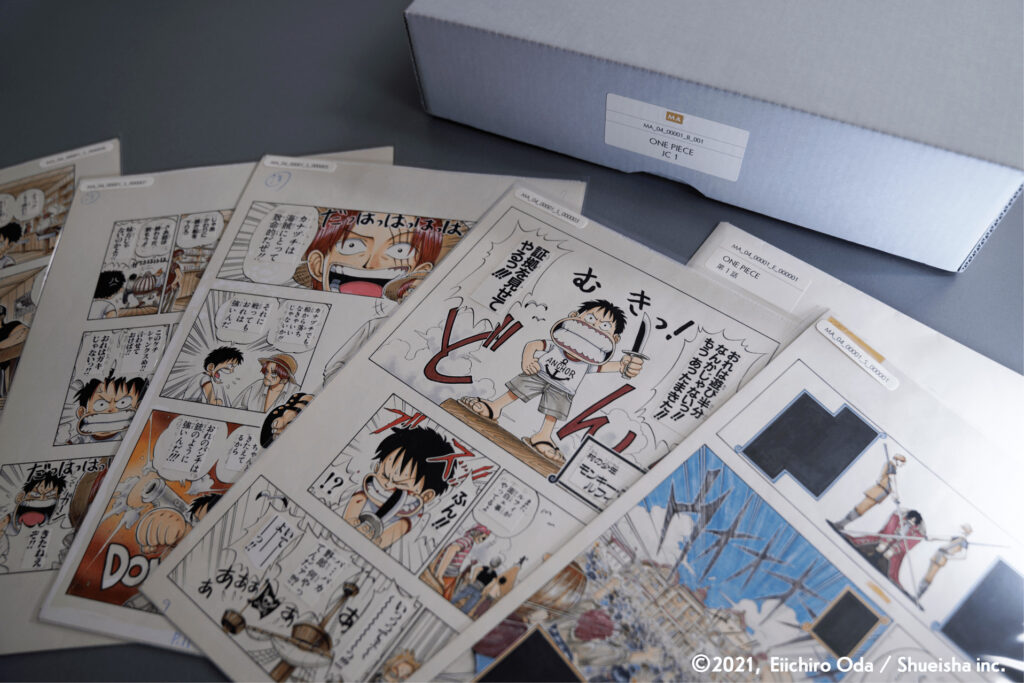Shueisha has launched "SHUEISHA MANGA-ART HERITAGE", a project to sell limited edition multiples of comics published by the company both in Japan and overseas. While there have been cases where comics have been distributed as posters and other reproductions, this is the first time in Japan that comics have been developed in the context of artwork. In conjunction with the launch of the e-commerce site, Masashi Okamoto, the director of the project, and Yasushi Iguchi of TRiCERA, which operates the cross-border e-commerce site for contemporary art, TRiCERA.net, had a conversation. which operates TRiCERA.net, a cross-border e-commerce site for contemporary art.
 Yasushi Iguchi (left), Masashi Okamoto (right)
Yasushi Iguchi (left), Masashi Okamoto (right)
©︎ Eiichiro Oda / Shueisha inc.
How to look at "manga" as art
Yasushi Iguchi (Iguchi) I'm sorry to be the first to say this, but first of all, as a manga fan, I'm very happy about this interview (laughs).
Masashi Okamoto (Okamoto): Thank you very much (laughs).
Iguchi: I'd like to talk about the "SHUEISHA MANGA-ART HERITAGE" that Shueisha is starting, and the possibilities of manga as art. Can I start by asking how you came up with the idea of developing manga as art, or how the project started?
Okamoto: If you go back to the beginning of the project, it actually started around 2007. At that time, there was a movement to digitally archive Shueisha comics, but at that time there were no smartphones, and there wasn't much momentum to do anything new with digital data. I was hoping to use the data for comics for gurakei (Japanese comic books) and for translation and publication overseas. It was a time when the term "digital archive" or the concept itself was still new.

Iguchi: Are you targeting all comics published by Shueisha?
Okamoto: Almost all of them.
Iguchi It's like a huge number... (laughs).
Okamoto: I will be (laughs). Shueisha publishes about 800 new comics a year, so that's about 3 million pages now. At the time, we used the best scanners made in Israel to create a high quality archive. Over time, with the smartphone revolution, it became possible to use archived data to produce digital comics. However, there were some works that were very well drawn, and I began to think, "Shouldn't this be released to the world in a different form? I started to think about it. I thought that it would be possible to release them in a different format, not in the size of comics, tablets, or smartphones, but in a different medium as well.
Isee. So you're saying that art is a way to output the archive you've created. What I find interesting is that the same picture looks different when it's made into a painting than when it's made into a comic. In comics, there is a story, and the experience is very fluid. But art, especially two-dimensional works, are basically fixed to the wall, and I think there is a big difference in the experience.
Okamoto: You're right, manga is a temporal art form, so if you take it out and look at it as a single picture, you'll see it differently. For example, even readers of "One Piece" may think, "Was there a scene like this? for example. I think there are different discoveries to be made when confronting a manga while it's hanging on the wall, compared to the comics.
Iguchi: Creating a different experience based on the content of comics.
Okamoto: Exactly. This project started as an archive, from the perspective of preserving original manga art, but I don't want to "just digitize it and be done with it" or make mere reproductions. I want to pass on the comics and the creations of the artists through different experiences, and I think that's where the significance lies.
How do we create value as art?
Iguchi: On the other hand, and this is a more practical point, I think there are many issues involved in "selling manga as art. On the one hand, there is the existing structure of the contemporary art industry, and on the other hand, there is the problem of how to create a position within it. And moreover, the art market itself is small compared to manga. What are your thoughts on entering an industry with a different market?
Okamoto: Let's start with some numbers. According to the USB report, the global art market is about 700 million yen. According to the USB report, the global art market is about 700 million yen, and the Japanese art industry is 359 billion yen. This figure itself is actually very familiar to me. In fact, the sales of digital comics in Japan in 2020 will be over 340 billion yen, which is roughly the same. Looking at this scale, I think it is not difficult to formulate a vision to grow "manga art" to a size of about 10 billion yen in 5 to 10 years.

Iguchi: If you think about the manga as a whole, it will be on a large scale.
Okamoto: That's exactly right, and Shueisha alone would have its hands absolutely full just working on "One Piece" and a few other manga. If other publishers' works were to be included, the size of the market could be expected to grow.
Iguchi: Moreover, "SHUEISHA MANGA-ART HERITAGE" is a cross-border EC, right? I think it was a shrewd decision considering that the overseas market is much larger than the art market.

Okamoto: Thank you very much for your evaluation. But I also don't want to go to bat with the existing genres in the "art market". I think there are various genres of art, whether it be painting or sculpture, and I don't want to compete with them in the market and take away their market share. I don't want to compete with them and take away their market share. It's not that I don't want to, it's that I don't think it's interesting.
Rather, I would rather collaborate with other genres. For example, you could collaborate with a craft artist to make a lacquered picture frame together. If you want to present your work as a work of art and as a Japanese creation to the world, it is important to collaborate with other genres.
Iguchi: While expanding manga into other genres of art, I would like to create a new value, or perhaps a symbiosis with existing art.
Okamoto: Yes, that's what I think is interesting. Until now, there have been posters and reproductions, for example. But nowhere has there been an idea to develop comics as artwork, to guarantee the quality of the art. Of course, this is the first attempt for Shueisha, and I think it's something new for the industry as well.
 ©︎ Riyoko Ikeda / Shueisha inc.
©︎ Riyoko Ikeda / Shueisha inc.
Iguchi: You just said "as art," but in that sense, I think the issuance of certificates using blockchain is interesting, or rather, it gets to the heart of the matter in a way. When I hear the words "blockchain" and "certificate," I can imagine that they would be thinking about distribution, value formation, and collateral. (laughs) I can imagine that when they hear about blockchain and certificates, they would be thinking about distribution, value formation, and collateral. This time, I think the work will be developed as a multiple work, and when that happens, it will be essential to talk about edition management.
Okamoto: That's right. That's exactly what made me realize the potential of this project in the first place. This time, I wanted to avoid being perceived as "selling reproductions". In that case, I needed to devise a way to manage the editions and distribution, or rather, a logic that would allow the works to flow into the market as works of art. In that sense, Startburn's blockchain system was a major catalyst.

Iguchi: I think there was a point in what you just said, that "distributing as art" is very important, and I think of contemporary art as a system rather than a genre. I think contemporary art is more of a system than a genre, but when you think about it like that, as I said earlier, edition management, or more specifically, market value management, is very important in the distribution of works that can be reproduced, such as prints and photographs.
Okamoto: I think you are right.
Iguchi: If we can just clear that, then I think that the ground has been laid. In contemporary art today, there is a tendency for people who were originally from the outside world, such as KAWS, to be accepted. So street art, pop art, and illustration have become a genre. Perhaps I'm overstating the case, but I think there's a basis for the new genre of manga to enter the scene. If I say something like this, I may be scolded again by people for saying too much (laughs).
Okamoto: No, but I understand what you are saying. But that's why it's important to create value with care. The same goes for packaging, shipping, and of course, certificates.
 ©︎ Shin-ichi Sakamoto / Shueisha inc.
©︎ Shin-ichi Sakamoto / Shueisha inc.
Iguchi: In France, manga is said to be the ninth art (laughs). But as you mentioned, contemporary art is a world of mechanisms, and there are rules to it. The fact that you have taken care of the "etiquette" or business practices is stoic, and makes me feel that you are serious about this project.
Okamoto: Speaking in this context, on the other hand, I'd like to avoid clashing with contemporary art, or rather, with the core of fine art. I'm conscious of the background of manga, and there are existing methods and techniques in fine art. I think it's not a good idea to try to force yourself to fit in there. Of course, I don't ignore it at all, and that's why we're talking about blockchain certificates... I want to establish it as art in a broader sense, and I think it is necessary to think about its own context and value.
I see. Also, in terms of value, this is my personal opinion, but I think that value is something that is perceived, and that value grows when a common value, or recognition, is created. The common value grows and the overall value is born. I'm very interested in how manga art can create value as art, and I see a lot of potential in this.
Manga art" as a way to pass on manga
Iguchi: To get to the heart of the matter, or to go into it a bit, what do you think is the biggest difference between this "SHUEISHA MANGA-ART HERITAGE" and the reproductions?
Okamoto: The biggest difference is research and restoration. In fact, original manga art fades and deteriorates very quickly. They are much more vulnerable than oil paintings. That's because the original drawings for weekly or monthly serialized manga often use dye-based inks that dry easily in order to adapt to the production speed. These inks make manga more expressive, but they also fade and discolor quickly. Also, there are many factors that can damage the paper, such as the adhesive used to attach the copy.
Iguchi: I see, so you don't have the idea of making the original image last longer because you assume it will be printed.
Okamoto: Yes, exactly. I've heard that some archive experts say that archives don't last for 100 years. This is even if they are stored in proper facilities. All of the original manga artworks are in a state of ongoing deterioration. That's why, when I make this work, I do research on what the original condition was like, and restore it while I'm working on it.
Iguchi: It's not simply a matter of printing, is it?

Okamoto: That's right. And unlike manga, the original image is enlarged rather than reduced. So, if you don't do everything properly, from photography to printing, you will end up with something that cannot be appreciated. From production to distribution, everything is done with a lot of control, so we can't simply say that we make reproductions.
Iguchi: By making it into art, we can preserve it.
Okamoto: By preserving them as pictures, that is, as something that gives a different experience from the state of the comics. Nowadays, I hear stories of paper originals being sold at a high price in auctions, but the originals are not being preserved in time. We have digital archives, but the original paper is only deteriorating. That's why if this project generates money, it can be used for research on the storage of original artworks, and of course, it can be returned to the artists.
Iguchi: We can create a new area of activity for manga artists, can't we?
Okamoto: That's exactly right, and the world of comics is getting tougher and tougher. It's difficult for artists to make a living on manuscript fees and royalties alone, but if they can use their drawings as art, they may be able to see different possibilities. In the future, I'd like to convert the drawings of new manga artists into art as well.
Iguchi: When you think about it like that, the goal of "SHUEISHA MANGA-ART HERITAGE" is pretty clear, isn't it? The inheritance of manga, and new possibilities for manga artists.
Okamoto: Manga is, after all, an important industry and culture in Japan. We have to think about how to pass it on while adapting to the times, and I think this is a problem that Shueisha, which has been sending manga out into the world, has to take seriously. I would like to continue to carefully and of course challengingly build up the question of whether manga as art is viable.

Masashi Okamoto / Masashi Okamoto
Director of "SHUEISHA MANGA-ART HERITAGE". After graduating from Tokyo National University of Fine Arts and Music, he joined Shueisha Co. After graduating from the Faculty of Fine Arts at Tokyo University of the Arts, she joined Shueisha Co. She has planned and implemented the "Comics Digital Archives," a database of major comics published by Shueisha. He was also involved in the digitization of the production environment for manga magazines such as "Shonen Jump". After transferring to the Digital Division, he launched "Manga Factory" and "SSDB (Shueisha General Database)".

Tai Iguchi
President and Founder of TRiCERA Corporation, Director of Japan Art Tech Association (JAAT) After graduating from university, he joined a long-established audio equipment manufacturer and started his career at the Asia Pacific Headquarters. In 2015, he joined Nike Japan Inc. and in 2017, he became the manager of the supply chain for directly managed stores in Japan, participating in global projects and launching and executing several new projects in Japan. On November 1, 2018, he established TRiCERA Inc.
Site URL
https://mangaart.jp/